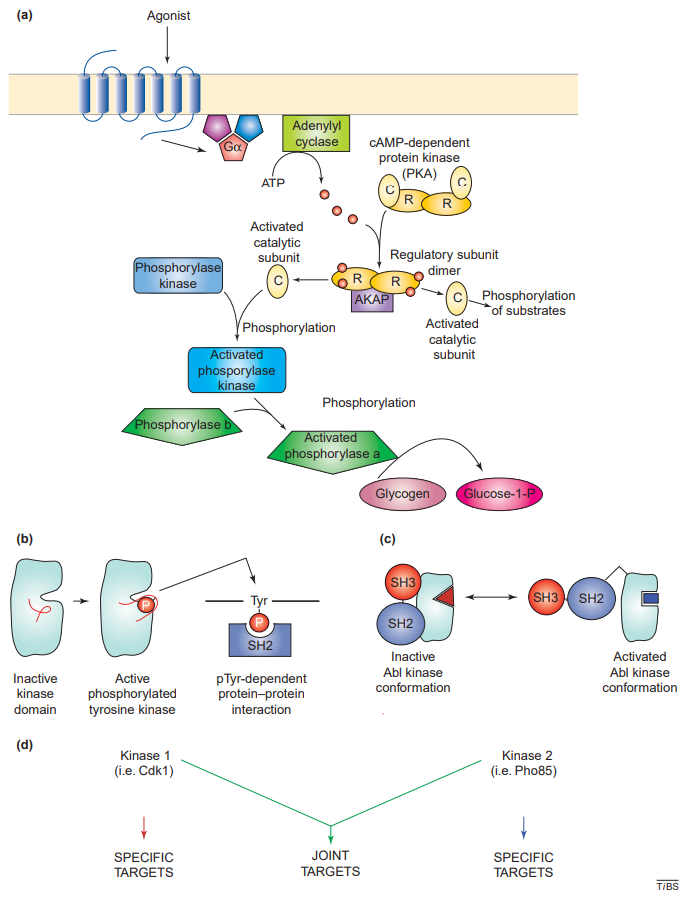To comply with the ICH Q6B guidelines for categorization of protein modification types, Creative Proteomics offers services for protein phosphorylation analysis. The business is committed to assisting clients from all around the world find novel therapeutic targets, identify protein kinase activity, diagnose and treat illnesses, among other things.
Protein Phosphorylation
Protein phosphorylation refers to the addition of a phosphate group (PO4) to a protein molecule. It is a post-translational modification that can regulate the activity, stability, localization, and interactions of proteins within cells.
Protein phosphorylation is mediated by enzymes called protein kinases, which transfer the phosphate group from adenosine triphosphate (ATP) to specific amino acid residues on the target protein, usually serine, threonine, or tyrosine residues. This process is reversible and can be counteracted by enzymes called protein phosphatases, which remove the phosphate group from the protein.
 Fig 1. Past, present and future themes in protein phosphorylation. (Pawson, T., & Scott, J. D.; 2005)
Fig 1. Past, present and future themes in protein phosphorylation. (Pawson, T., & Scott, J. D.; 2005)
Protein Phosphorylation Analysis Technologies
Antibody-based detection

This technique pertains to the employment of antibodies with a particular affinity for phosphorylated proteins. These antibodies, both commercially procured and laboratory synthesized, are produced using a variety of approaches. The selective usage of antibodies, such as phospho-specific or pan-phosphoprotein antibodies, allows detection of specific phosphorylation sites or a more extensive set of phosphorylated proteins respectively.
Mass spectrometry

Mass spectrometry techniques have become an essential toolbox for the discernment and volumetric analysis of phosphorylated proteins. This methodology typically necessitates the fragmentation of proteins into peptides, which are then subject to analysis via mass spectrometry. The recognition of phosphorylated peptides can be deduced from their mass shifts induced by the incorporation of a phosphate group.
Phosphoprotein staining

Phosphoprotein staining represents a sophisticated technique involving the employment of specialized dyes that exhibit selective binding affinity towards phosphorylated proteins. By virtue of its selectivity, this particular staining protocol can be integrated with other protein identification methodologies such as Western blotting or gel electrophoresis. This combination allows for the precise visualization of the presence of phosphorylated proteins.
In vitro kinase assays

In vitro kinase assays represent distinct biochemical analyses, specifically designed to ascertain protein phosphorylation detection. These assays offer a way to assess the transfer of phosphate groups from ATP onto a specific protein of interest. The technique is extensively utilized by researchers aiming to comprehend the activity of protein kinases and understand their corresponding substrates within the realm of biology.
Phospho-specific mass tags

This methodology involves the innovative utilization of synthetic mass tags which are introduced onto phosphate groups inherent in proteins. Subsequently, the application of mass spectrometry facilitates detection of these mass tags. This process consequently enables not only the identification but also the quantification of proteins that have undergone phosphorylation.
Application of Protein Phosphorylation
Cell signaling: Protein phosphorylation is a key component of cellular signaling pathways that enable cells to react to outside stimuli and control a number of functions, including cell growth, differentiation, apoptosis, and metabolism.
Diseases research: Protein phosphorylation dysregulation has been linked to a variety of illnesses, including cancer, neurological diseases, and metabolic disorders. Identifying the function of phosphorylation in illness pathways can help in the creation of specialized treatments.
Drug development: Protein kinases, which control phosphorylation processes, are enticing targets. Specific kinases can be inhibited or modulated to change signaling pathways and possibly treat illnesses.
Biomarkers: Phosphorylation events can be used as biomarkers to diagnose diseases, predict how they will progress, and gauge how well treatments are working. Clinicians can learn more about the development of a disease and the effectiveness of a treatment by keeping track of particular phosphorylation events.
Why Choose Us?
- We have a proven and reliable technology platform to help our customers break through all the barriers of protein drug characterization research projects.
- We have high-quality protein drug characterization services to meet all the needs of our global customers.
- We have experienced experts in the field of organic chemistry to provide you with the most effective and high quality solutions.
Our Goals
Protein durgs have transformed medicine by offering efficient therapy alternatives for a variety of disorders. In order to suit the demands of our clients, Creative Proteomics provides a comprehensive range of protein drug characterization services. Characterizing protein therapeutics entails studying their structure, function, and interactions. Please feel free to contact us if you have any questions about the services offered by our campany.
Reference
- Pawson, T., & Scott, J. D. Protein phosphorylation in signaling – 50 years and counting. Trends in Biochemical Sciences. 2005, 30(6), 286–290.
Related Sections
Services
Applications
For research use only, not intended for any clinical use.


 Fig 1. Past, present and future themes in protein phosphorylation. (Pawson, T., & Scott, J. D.; 2005)
Fig 1. Past, present and future themes in protein phosphorylation. (Pawson, T., & Scott, J. D.; 2005)








